
Apollonio di Giovanni and workshop
Journey of the Queen of Sheba, c. 1464–5
Tempera on panel, 43.2 x 176.2 cm (17 x 69 3/8 in.)
Birmingham Museum of Art, Gift of the Samuel H. Kress Foundation
1. Models for the bride
Some workshops, including that of Apollonio di Giovanni, made cassone and spalliera panels something of a specialty. Records suggest that between 1446 and 1465, Apollonio’s shop was turning out nine or ten chests each year. While some decorations might seem a bit risqué to modern sensibilities—or in the case of scenes of rape, even bizarre—the episodes treated on these two panels are decorously pious and offered moralizing exemplars for a new wife. Similar depictions of Solomon and the queen of Sheba appear on several works from Apollonio’s shop.

Apollonio di Giovanni and Marco del Buono di Marco
Meeting of Solomon and the Queen of Sheba, c. 1464–5
Tempera on panel, 52.5 x 185.5 cm (20 11/16 x 73 1/16 in.)
Museum of Fine Arts, Boston, Bequest of Mrs. Harriet J. Bradbury
Biblical accounts (in 1 Kings 10 and 2 Chronicles 9) describe the journey of the queen of Sheba to Israel, where she wanted to witness for herself the reputed wisdom of King Solomon. She was accompanied by a huge retinue, her camels laden with spices and gold. Meeting the king and seeing the happiness of his wives and his people, as well as the bounty of food on his table, the queen was moved to accept the greatness of Solomon’s god and left the king with the richest treasure of gifts he had ever received.
The wide format of these panels was ideally suited for the depiction of the queen’s long retinue. Her journey, of course, paralleled that of a new bride to her husband’s home—both accompanied by rich goods. During the Middle Ages the tale was elaborated to include an episode in which the queen halted her entourage before a bridge, unwilling to walk across it because she recognized that its timbers were made of wood from the True Cross. For Renaissance audiences the message was clear: brides ought to tread with similar caution and care.
In the second panel, the queen presses her hand modestly to her heart as she greets the famous king. In Christian terms this episode was seen as foretelling the reception of Christ by the church. In a more directly personal way, the queen’s acceptance of Solomon’s wisdom and standing was a model for a bride to follow as she, even if highborn, likewise acceded to the authority of her new husband.
The story of the queen of Sheba’s trip to Solomon’s kingdom, as a meeting of East and West, also had particular relevance in Florence, where in 1439 delegates of the Eastern and Western churches, including Byzantine emperor John Paeleologus, met in an attempt to reconcile doctrinal disputes.
John VIII Palaeologus
Solomon’s conical hat is similar to that worn by the Byzantine emperor on this medal, cast in Florence at the time of the emperor’s embassy there. But in medieval and Renaissance iconography generally, such hats were associated with the East and with Jews.
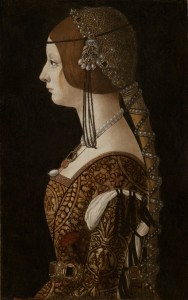
Ambrogio de Predis
Bianca Maria Sforza, probably 1493
Oil on panel, 51 x 32.5 cm (20 1/16 x 12 13/16 in.)
National Gallery of Art, Washington, DC, Widener Collection
Image courtesy of the Board of Trustees, National Gallery of Art
Married at two and widowed at ten, Bianca Maria Sforza (1472–1510), like all aristocratic women, was a dynastic asset. This portrait was probably made around the time of her second marriage, to the Holy Roman emperor, Maximilian I. The wedding was celebrated with great fanfare in Milan on November 30, 1493 (see “Description of Bianca Sforza’s wedding”). Scores of dignitaries from across Europe attended, but the groom himself did not; only seven months later did Bianca, then twenty-one, meet the man she had married by proxy. By all accounts Bianca’s marriage was an unhappy one. She was largely ignored by her husband and his court and raised the two children born to Maximilian and his much-loved first wife while remaining childless herself. Nevertheless, both families could count the match a success: each party to the transaction got the advantage it sought.
Bianca’s uncle, Ludovico Sforza, called Il Moro, needed a prestigious alliance to legitimate his authority as the duke of Milan. It was the title he had usurped from Bianca’s younger brother after their father, Duke Galeazzo Maria Sforza, had been assassinated. In exchange for investing Ludovico as duke, Maximilian received much-needed funds in the form of Bianca’s generous dowry. This amounted to some one hundred thousand ducats (equivalent to more than 770 pounds of gold), a large share of which was counted in the jewels and clothes of her dowry. The headdress ornament painted here was alone valued at six hundred ducats, six times what a skilled craftsman earned in a year. Made of rubies, emeralds, diamonds, and large pearls, it is in the form of a small brush (scopetta), one of the Sforza family emblems. Brushes also appear in the brocade patterns of Bianca’s dress, along with evergreen foliage, which was another element of Sforza heraldry.
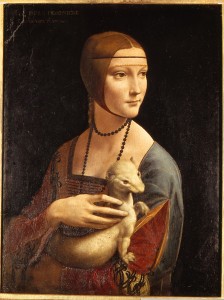
Leonardo da Vinci
Lady with an Ermine (Portrait of Cecilia Gallerani), c. 1490
Oil on panel, 54.8 x 40.3 cm (21 5/8 x 15 7/8 in.)
Muzeum Czartoryskich, Krakow
Scala/Art Resource, NY
In fact, the conspicuous display of wealth and the specific deployment of Sforza devices—more than the bride herself—is the focus of this image. It is a state portrait, meant to reveal the Sforza’s wealth and Bianca’s status but telling us little about the subject as a person. This lack is due in part to her strict profile pose. Profile portraits were already considered a bit old-fashioned by the late fifteenth-century date of this painting, but they remained in favor in aristocratic Milan—and perhaps especially with a new duke anxious to establish his bona fides—because they emphasized the sitter’s status. (Compare the portrait of Cecilia Gallerani). Derived ultimately from ancient Roman coinage, profile portraits were associated with rulership and projected the hauteur expected in society’s highest echelons.
Probably, this portrait was painted upon Bianca’s betrothal to Maximilian. A carnation, a flower associated with marriage, is tucked into her heavily jeweled belt, which is itself an allusion to her virginity. An envoy representing the emperor (or perhaps, instead, a rival suitor, the duke of Saxony) had traveled discreetly to Milan for the express purpose of seeing the prospective bride, which he managed to do as she attended church. At that time the envoy acquired a drawing of Bianca from Ambrogio de Predis, the court painter in Milan. The envoy returned to make further inquiries about Bianca’s parentage and request a second portrait of her from de Predis, this time in color—perhaps this very painting. In circumstances such as those of Bianca and Maximilian, in which couples were engaged or even married before they met, portraits served as a sort of introduction. They also offered a measure of guarantee: the bride’s beauty and suitability could be assessed, and foreknowledge of her features could expose an impostor.
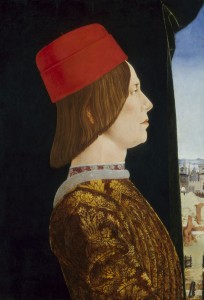
Ercole de’ Roberti
Giovanni II Bentivoglio, c. 1474/77
Tempera on panel, 54 x 38.1 cm (21 1/4 x 15 in.)
National Gallery of Art, Washington, DC, Samuel H. Kress Collection
Image courtesy of the Board of Trustees, National Gallery of Art
3. Power portraits
When Giovanni Bentivoglio, lord of Bologna, married Ginevra (1438–1507) in 1464, she was the recently widowed wife of his cousin and predecessor and a few years older than him. (Giovanni apparently lobbied unsuccessfully for a younger bride.) Illegitimate niece of the powerful Francesco Sforza, duke of Milan, Ginevra had been married to Sante Bentivoglio at age twelve in a match that cemented Sforza support for the Bentivoglio. The family had consolidated power in Bologna, nominally a papal territory, by playing off the competing interests of neighboring states and the pope. Having no title, Sante and then Giovanni ruled Bologna de facto as “first citizen,” a privilege Giovanni was granted for life. Although he and Ginevra held power for some fifty years, the position did not, in fact, prove to be lifelong. The couple was forced into exile in 1506, when a more aggressive pope, Pope Julius II, took back direct control of the city.
Ginevra, who bore Giovanni sixteen children (and Sante two), was described in contemporary accounts and correspondence as having considerable sway over her husband. He himself complained of her influence after events had gone wrong (see sidebar). Her biography appeared in two collections of the life stories of famous women, one of which, from 1483, was dedicated to Ginevra (and titled Gynevera de le clare donne, playing on her name, the Greek word gyne [woman], and the Latin vera [truth]). This work by Giovanni Sabadino degli Arienti, although filled more with formulaic praise than biographical fact, departed from earlier compendia by presenting not only figures of ancient or biblical history but also contemporary women noted for their accomplishments in statecraft, scholarship, literature, and other endeavors.
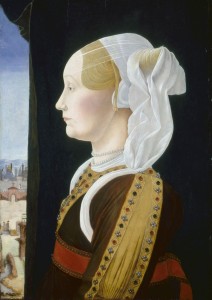
Ercole de’ Roberti
Ginevra Bentivoglio, c. 1474/77
Tempera on panel, 53.7 x 38.7 cm (21 1/8 x 15 1/4 in.)
National Gallery of Art, Washington, DC, Samuel H. Kress Collection
Image courtesy of the Board of Trustees, National Gallery of Art
The pair of portraits by Ercole de’ Roberti probably postdates the couple’s marriage in 1464 by more than a decade. Painted when their position was at its strongest, the images proclaim their power through magnificence. A sliver of landscape opens in a window to the side of each, but their profiles—the pose emphasizing rank and aristocratic reserve—stand out with clarity and vigor against a dark curtain (originally a more brilliant blue). Portraitists had begun to paint sitters against full landscapes by this time, but this older style may have helped the title-less Giovanni assert his position among the nobility.
Giovanni’s chin is elevated, with his entire head tilted upward at an angle to convey masculine power and an active nature. Ginevra looks across to him levelly, directly confronting his eye; the springy line of her veil animates her otherwise static formality. The male in Renaissance portraits typically has the position of greater honor, namely, on the left as read by the viewer. That is the case here, although in some other portraits where the Bentivoglios appear together it is she who occupies the dexter. Ginevra’s features are more idealized than her husband’s, while his coloring is higher—these are also standard differences between Renaissance male and female representations. Her blond hair may or may not reflect Ginevra’s true appearance. Portraits often depicted women (and some men) as blonds; golden hair was not only a standard of beauty but also a symbol of virtue and purity. And it was those moral attributes rather than power and ambition that a female portrait sought to convey, whatever the individual circumstance might have been. Like Ginevra, other aristocratic women may well have wielded influence not detected from their portraits.
The Bentivoglios’ position—and wealth—is announced most clearly by their dress. He wears rich brocade (in the red and gold of the Bentivoglio arms) with expensive fur lining, she a pearl-studded belt and soft velvet gown with jeweled bands at the neckline and along the sleeve opening. The slit sleeve reveals the gathered, gold-cloth chemise worn underneath it. To paint this luxurious fabric, Ercole used mosaic gold, a pigment normally applied only in manuscript illumination.
Portraits like these were made as official images, not personal remembrances. This pair was likely intended for the couple’s palace in Bologna, but such portraits were often presented as gifts to powerful supporters to cement allegiances and bolster authority. Recipients considered them indications of their own status, often displaying them in public rooms or even in bedchambers (which were spaces notably less private than bedrooms today).
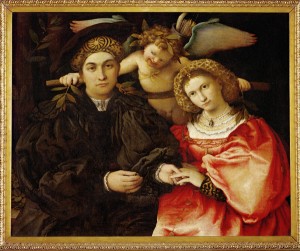
Lorenzo Lotto
Marsilio Cassotti and His Bride, Faustina, 1523
Oil on canvas, 71 x 84 cm (27 15/16 x 33 1/16 in.)
Museo del Prado, Madrid
Erich Lessing/Art Resource, NY
4. The yoke of matrimony
Lorenzo Lotto was an inventive painter who used novel formats to explore complex personal circumstances and emotional states. This double portrait, not a common type in Italy, is clearly a wedding portrait. Lotto painted it while working in Bergamo, then part of Venetian territory. Because the couple looks out at us directly, we are made witnesses to the action: the man takes his bride’s hand to place a ring on her finger. He seems to search for the vein that Isidore of Seville (and later writers) believed ran directly to the woman’s heart.
Cupid, directing a sly look to the groom, hovers above the couple. His arrows safely in their quiver, he shelters man and wife with iridescent wings. Over their shoulders, a yoke symbolizes the tie that now binds them and unites their futures. Laurel leaves at their shoulders signal chastity and the victory of matrimony, if not love.
Despite the symbolism, Lotto has undoubtedly recorded an actual ring ceremony in this painting. The man has been identified via descriptions of the painting in inventories and accounts as Marsilio Cassotti. His wife is presumably Faustina Assonica. In 1523, when the painting was made, Marsilio would have been barely twenty-one years old, young for a groom in Venice, where the average age of men at marriage was thirty. The year before, Marsilio’s father had emancipated his son, again at an early age. Most men did not fully enter that official stage of adult life until their twenty-fifth birthday. Only then were they free of the obligation to obey their fathers and granted a share of the family fortunes; they became, for the first time, independent agents of their own lives.
The painting was described as having been made by Lotto not for the new couple, but for Marsilio’s father. Perhaps the cupid’s look toward Marsilio—wry and playful—communicates a father’s judgment on his son as a man in a hurry, possibly too eager and not fully aware of the bonds he is undertaking.
![Pisanello<br /><i>John VIII Palaeologus (1392–1448), Emperor of Constantinople (1425)</i> [obverse], 1438<br />Lead, trial cast, diameter 10.38 cm (4 1/16 in.)<br />National Gallery of Art, Washington, DC, Samuel H. Kress Collection<br />Image courtesy of the Board of Trustees, National Gallery of Art](http://italianrenaissanceresources.com/wp-content/uploads/2013/02/RP_1541-1.jpg)